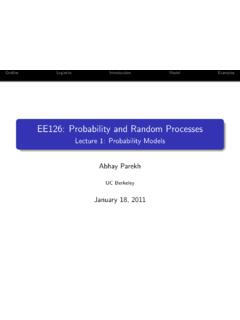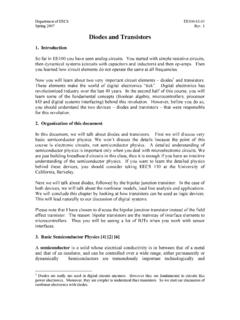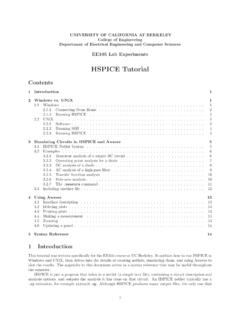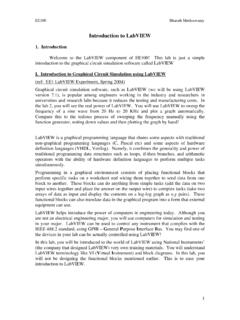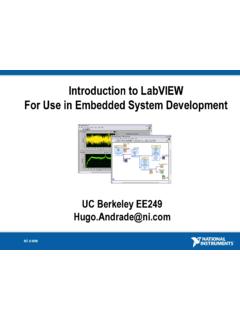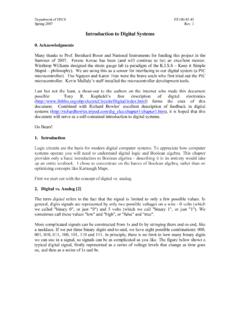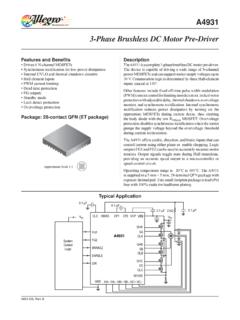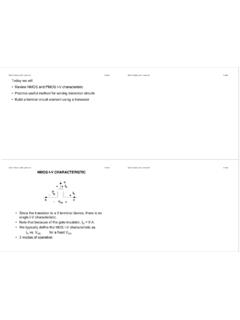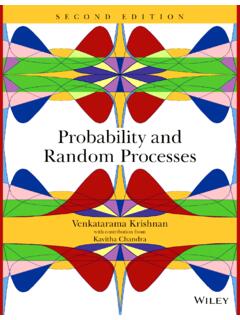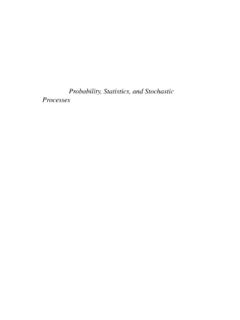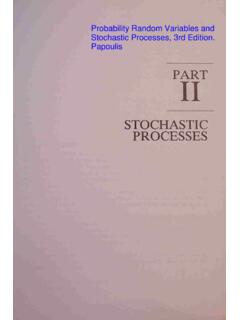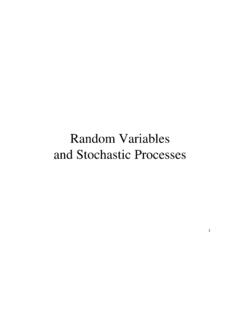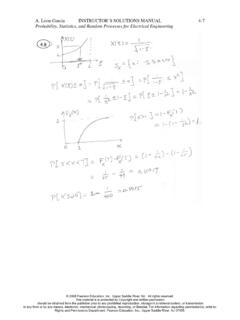Transcription of EECS 126 Probability and Random Processes: Course Syllabus ...
1 EECS 126 Probability and Random ProcessesUniversity of California, Berkeley: Spring 2018 Kannan RamchandranEECS 126 probability and random processes : Course Syllabus1 Administrative Info Instructors: Prof. Kannan Ramchandran, 269 Cory Lectures: Tuesday/Thursday, 2:00 - 3:30 , 100 Lewis (no webcast) TAs: Tavor Kaylee Gary Sinho Hemang Alvin Vrettos Ray Readers: William Chen Kanaad Note: All emails that do not start with [EECS 126] followed by a spacewill not be answered. Discussions: Section 201: Wednesday, 9:00 - 10:00 , 209 Dwinelle Section 202: Wednesday, 10:00 - 11:00 , 140 Barrows Section 203: Wednesday, 11:00 - 12:00 , 3113 Etcheverry Section 204: Wednesday, 8:00 - 9:00 , 521 Cory Hall Section 205: Friday, 11:00 - 12:00 , 521 Cory Hall Section 206: Friday, 4:00 - 5:00 , 521 Cory Hall Section 207: Friday, 10:00 - 11:00 , 293 Cory Hall Section 208: Friday, 12:00 - 1:00 , 293 Cory Hall Office Hours: Prof.
2 Kannan Ramchandran: Tuesday, 4:00 - 5:00 , 269 Cory Hall TA office hour times will be posted on the Course website. Homework Parties: Monday, 6:30 - 9:00 , 521 Cory Hall Thursday, 6:00 - 8:00 , 212 Cory Hall Course Website: ~ee126/sp18/12 Course Info Description: Probability is a mathematical discipline that allows one to reason about uncertainty: it helpsus to predict uncertain events, to make better decisions under uncertainty, and to design and build the Course , we will teach you the fundamental ideas of Probability and Random processes alongwith the labs. The hands-on assignments are carefully designed so that they demonstrate how the mathematicalconcepts can be used to design and build modern systems in many engineering and scientific fields includingcommunication systems and networks, machine learning, signal processing, computational biology, and controlsystems.
3 Prerequisite: Knowledge of Probability at the level of CS 70 or STAT 134. Familiarity with linear algebra. Textbooks: (BT) Dimitris P. Bertsekas and John N. Tsitsiklis, Introduction to Probability , 2nd Edition, Athena Scien-tific, 2008. (W) Jean Walrand, Probability in Electrical Engineering and Computer Science: An Application-DrivenCourse, Amazon, 2014. (e-book available) Course Outline: The Course consists of 3 modules as : The labs listed below are M1. Fundamentals of Probability / 4 weeks / Main reference: BT Labs: Introduction, Auctions, Huffman Codes/Active Learning Review: Discrete & Continuous Probability Conditioning, Convolution, Transforms Bounds, Convergence of Random Variables, Information Theory2.
4 M2. Random processes , Coding / weeks / Main reference: BT & W Labs: Coding, Sampling, Random Graphs Markov Chains (Discrete Time, Continuous Time), Queuing Poisson Process Random Graphs3. M3. Inference, Learning / 4 weeks / Main reference: BT & W Labs: Project, Viterbi Algorithm, Kalman Filter, EM Algorithm Detection, Hypothesis Testing, Communication Estimation, Hidden Markov Chains, Kalman Filter Expectation Maximization & Clustering3 Grade / Homework / Discussion Forum / Exams / Schedule Course Grading: Homework (10%) Lab (5%) Project (5%) Midterm 1 (20%) Midterm 2 (20%) Final (40%) Homework Weekly homeworks will be assigned every Friday, and must be submitted by11:59 of the followingWednesday, asa PDF file on Gradescope.
5 Lab assignments will typically be due onFriday, 9:59 ,and bothPDF and IPYNB files are submitted to Gradescope. It is your responsibility to ensurethat all assignments are submitted on Gradescope by the deadline. We will not accept late assignments dueto technological issues, so please submit two hours earlier than the official deadline to give yourself time toresolve these Homeworks, solutions, and general announcements will be posted on the Course website. Each homework should be self-graded and the self-graded score should be submitted online by5 ofthe following Monday. For detailed description of self-grading policies, please refer to Section 4.
6 We will automatically drop 2 homeworks with the lowest scores. No late submission or self-graded score accepted. Any homework that is illegible or too difficult to read will get a 0. Discussion Forum We will be using Piazza for class discussion only. Rather than emailing questions to the GSIs, we encourageyou to post your questions on Piazza. GSIs will answer some of unresolved questions on the forum on everyMonday and Wednesday. Find our class page Exams Midterm 1: Wednesday, February 14 (7-9 ) Midterm 2: Wednesday, March 21 (7-9 ) Final: Monday, May 7, 11:30 - 2:30 Course Schedule (subject to change)#MaterialsReference1 Introduction, Probability Spaces, Conditional Probability , BayesRule, Independence, Discrete Random Variables & Distributions,Expectation, Joint DistributionsBT 1-22 Variance, Indicators, Coupon Collection, Continuous ProbabilityBT 23 Continuous Random Variables & Distributions, Convolution,GaussiansBT 34 Transforms, Inequalities (Markov, Chebyshev, Chernoff), Law ofLarge Numbers, Central Limit TheoremBT 4-55 Entropy, Relative Entropy, Capacity of the BEC, Shannon s The-orem, Midterm 1 Notes6 Discrete Time Markov Chains.
7 Hitting Time, Classification ofStatesW 1, BT Time Markov Chains: Stationarity, Convergence, Re-versibility, Bernoulli Process, Poisson ProcessW 1, , B-T Process: Merging, Splitting, Conditioning, ContinuousTime Markov Chains, QueueingW , B-T , Graphs, Maximum Likelihood Estimation, Maximum APosteriori EstimationW , B-T , , Notes10 Coding, Midterm 211 Spring Break12 Communication, Cram er-Rao Bound, Fisher InformationNotes13 Detection, Hypothesis Testing, Neyman-Pearson Paradigm, LeastSquares Estimation (LLSE, MMSE)W , , , B-T , , Notes14 Joint Gaussians, Kalman FilterW , , Notes15 Hidden Markov Chains, Viterbi Algorithm, Expectation Maxi-mization, ClusteringW 94 Homework Policy Collaboration.
8 Discussions about homeworks are allowed and encouraged, but each student is expected towrite his/her own Self-Grading: Students should submit a pdf or photocopy of each assignment for self-grading and futurereference. One copy will be turned online by the due date. The solutions will then be posted on bCourses onthe same day, and the students will use the second copy to grade their own can earn one of 4 possible scores for a problem:0,1,2, and3. If your solution is entirely correct, you get3points. If your solution is more than 66% correct on a single-part problem, or if you solve at least two-thirdsof the parts entirely correctly for a multi-part problem, you get2points.
9 If your solution is more than 33%correct on a single-part problem, or if you solve at least one-third of the parts entirely correctly for a multi-partproblem, you get1point. Otherwise you get0points for the sample and grade the submitted copies and check for inconsistencies with the self-graded scores. Please notethe department policy on academic dishonesty: Submission of Homework and Self-Grades: You must submit both a PDF file for each homework and anIPYNB file and a PDF file for each lab through Gradescope. After grading each assignment based on a postedsolution, self-graded scores will be submitted via Google Forms, to which a link will be provided with
